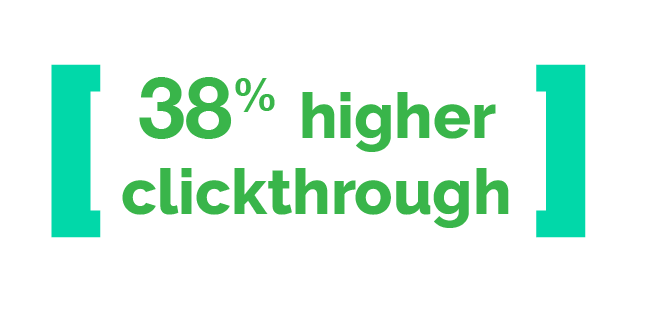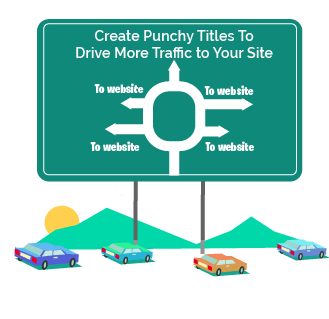What made you click on this blog post? Was it the jazzy image that headlined the title? Or the captivating headline that tapped into your needs?
Punchy titles can make or break your content.
Unless you’ve got a title that’s going to capture your target audience’s attention, it’s pointless spending your time creating it.
Great titles give you an edge. They convince your audience to read and engage with your content. Whereas a badly written line will only encourage searchers to keep scrolling until they find something more appealing.
This claim is backed by evidence too. Recent research has found that 80% of readers never make it past the headline. While a page’s traffic can vary by almost as much as 500% simply because of the headline.
So, what does this mean for you?
As a marketer or content creator, this means that without a compelling title, only a small proportion of readers will actually click-through. Why go to all that effort creating content if no one is going to read it?
You need to spend the time tweaking your titles to perfection. That way, you can ensure they stop searchers from scrolling. As well as encourage them to click onto your website.
Creating punchy titles doesn’t require a lot of skill or creativity either. It’s about being direct, encouraging, and shouting about why your content is worth their time and attention.

Here are 8 tips guaranteed to help you craft punchy titles and attach more readers to your website.
1. Be Accurate
Accuracy is critical when creating your title. A title sets out clear expectations for your readers as to what they can expect from your content.
Never inflate or over-exaggerate promises within your title that aren’t an accurate reflection of what they can expect to read. If you do, you’ll be harming your relationship with the reader before they’ve even finished reading your article.
As a result, they won’t trust your brand. And, you can forget even thinking about turning them into prospective customers in the future.
Sometimes, adding bracketed clarification to your headline can help ensure accuracy. It encourages users to trust that the content you’ve written best fulfils their search query.
For instance, the following titles;
- ‘How to Polish Out Scratches from Your Car [Video]
- ‘5 Statistics That Prove Content Marketing is Effective [Updated Jun 2020]’
They give further clarity to the reader about both the relevancy of the article and its accuracy.
In fact, in a study of over 3 million paid link headlines, HubSpot found using brackets to be effective. Their study found that titles using brackets within their titles, had a 38% higher click-through rate than those that didn’t. 
Why?
They say, ‘it’s all about setting clear expectations…readers knew exactly what they were getting themselves into before they even clicked.’
So, always remember that one of the most important rules in title-creation is accuracy. Respect the reader experience by setting clear expectations from the start. If you can’t fulfil those, you’ll lose their trust.
2. Use Superlatives

Superlatives are exaggerated or hyperbolical adjectives, used as an expression for describing something.
Examples include words like ‘biggest,’ ‘cheapest,’ ‘best,’ and ‘greatest.’ And as you can probably guess, they have the potential to add a lot of richness to your titles.
Take the title; ‘Cheap Wedding Photographer Packages.’ By adding the superlative ‘cheapest’ to create ‘The Cheapest Wedding Photographer Packages,’ you’re going to be way more appealing than if you had kept the previous title.
Similarly; ‘Great Ways to Save for a House Deposit’ sounds more appealing when rewritten as ‘The Best Strategy for Saving for a House Deposit.’
Where you can (and without deceiving your audience), use superlatives in your titles. They will effectively entice your audience in.
Of course, for every piece of content you create, you should strive to be of the ‘best’ quality. And it should also be the most helpful content out there. As such, you shouldn’t have any trouble in using superlatives within your titles.
3. Order Your Words
When we read anything in print or digital, in the UK at least, we read words from left to right.

So, when writing your titles, place your most important words as close to the left as possible. As a result, you can capture your reader as their eyes first hit the screen.
This can be critical for your keywords too. If your audience scans a page of search results and sees your keywords first, chances are they’re going to click on your content.
An easy way to do this is to place keywords at the start, followed by a colon, such as:
- ‘Social media: 3 trends to follow this year’
- ‘Making pizza: A quick and fool-proof dough recipe’
- ‘Buying Christmas presents: your no-nonsense guide to the best deals’
These words will help to capture those people quickly flitting through a page of search results. These people may have missed your article if the keyword was not placed in their direct eyeline.
4. Write For Your Audience
It sounds like an obvious point, but one which so many marketers fail to do.
They become too focused on producing titles which are optimised for search engine rankings. As opposed to thinking about their audience. This is a mistake because the people reading, listening or watching your content are the ones who will share your content.

After all, your audience is human, so write for them, not search engines.
You can catch them from a mile off with titles which look as they’ve been plucked straight out of a keyword research tool. For example:
- ‘5 Tips to Help You Destress From Work’
- ‘The Best Free Website Building Tools’
- ‘10 Black Dresses to Die For this Autumn’
But at the end of the day, what’s going to drive your rankings upwards? The search engine where your content is hosted? Or the people who are actually engaging with your content? Of course, it’s the latter.
Your audience are the ones who are going to be reading your content. As such, you need to write a punchy title which really appeals to them and taps into their needs. After all, their search is probably what has prompted you to create the blog post in the first place. So make the title appeal to them in the same way your actual content does.
Think about it in the following way. If you were scrolling on social media, what kind of title would stop you in your tracks. What is it about a title that encourages you to read on?
Use your title to speak directly to your audience and persuade them that your content can help them. Active language and direct address are a great way of doing this.
For instance, take the title; ‘How to Activate Your Quads And Tone Your Legs Quickly’. This will probably have a stronger impact than ‘Tips For Toning Your Legs.’
Don’t be afraid to test your titles either. If you’re using paid ads to promote your content, you can A/B split test two different ads. Trial two different titles and then implement the one which works best.
5. Track Your Most Popular Titles
Sometimes, the inspiration you need to create a punchy title can be found from the content you already have.

Once you’ve created a bank of blog posts and articles, utilise your website analytics. Assess which posts appear to be having the most impact on your readers. Look at metrics such as pageview, time on page, and bounce rate. You can see which posts your visitors are engaging with. Then, consider what it is that’s driving their success.
Could it be the title? Or the keywords included in it?
Of course, your content’s success could be solely down to having written about a trending topic. Or something which the majority of your target audience are interested in reading.
But consider if you have done anything different with your title compared to your other posts. Even the inclusion of a modifier can have a dramatic effect on the power of your title.
6. Monitor Competitors’ Titles
Your competitors’ content can give you great insights into the kind of titles which work best for your industry and give you some ideas on how to improve your own.

While you don’t have access to your competitors’ website analytics, you can use other metrics to determine the effectiveness of their titles. For example, the numbers of shares or likes a post has can give you a ballpark idea of their effectiveness.
A good indication of whether their titles are more impactful than yours is to compare a topic you’ve both created content on. See which one appears to be having the best success amongst your audiences.
Then take a step back and compare both of your titles. If theirs is more successful, is there something in their title which yours is missing? Does theirs just read better?
Maintain a list of these titles and then adapt them to suit your blog’s content. But never copy them verbatim!
7. Play With Figurative Language
Another way to help make your titles pop is to flex your creative muscles. Try dabbling with a few language techniques.

There are a few things you can experiment with, including:
- Alliteration: Where your title includes two or more words that start with the same letter, placed next to each other. Examples include ‘Greatest Guide,’ ‘Critical Content Considerations’ and ‘Effortlessly Easy.’ Making the words roll off the tongue, this technique can have a strong impact on your reader.
- Metaphors: Visual forms of expression that create vivid imagery. Examples include: ‘Time is Money,’ ‘Living Life on the Edge,’ and ‘Abs of Steel.’ Metaphors are a great way of getting your content’s main message across without needing to use excessive words.
- Use strong language: Just like the use of superlatives, using other forms of strong language can also be effective. Examples include ’5 Things Cats Hate,’ ‘How To Be Brilliant At Ice Skating’ ‘Smock Dresses We Love This Season.’ Putting emotion into the title brings the text alive. Again, making your writing more visual and persuasive for readers to click on.
Of course, anything you write needs to resonate with your core readership. So never go too over the top with what your reader should expect.
Make sure your titles align with your target readership but still offer an element of creativity. It’ll set the foundations for what your audience can expect with the rest of your writing.
8. Keep It Short & Sweet

Titles are only meant to hint at what your article has to offer, not tell the whole story.
You want to strike a careful balance with them. Keep them short so as not to discourage your reader from wanting to click through and read on. But keep them long enough that they share enough detail with readers about what to expect from your content.
It’s also important to note that you may need to vary the length of your title to best serve different purposes.
For example, if you want to optimise your title to perform well for SEO ranking purposes, it’s best to keep it quite short.
Most search engines cap their meta title display length between 50-60 characters. So you want to keep your title within this limit to ensure the searcher can read it all. If not, your title will be cut off. And they could miss that crucial hook that makes them want to read on.
However, research shows that titles between 12-14 words in length tend to have the most shares on social media.
As you can see, there’s no one size fits all formula. As such, you’ll probably want to experiment with your title length to see which resonates best with your audience.
Summary
Despite how great your content is, unless you have a captivating, punchy title to entice readers in, it won’t get read.
The perfect title doesn’t exist. In fact, there are so many factors which go into crafting them. Therefore, only you will be able to discover the perfect ‘style’ of title-creation for your audience.
As with everything in content marketing, ensure your titles are as authentic and as high-quality as they can be. This will ensure they best reflect the work your audience should expect to read.
By using metrics to track and measure your click-through rate and pageviews, you’ll be able to make guided changes. Tweak your titles when necessary, until you find a way which clicks with your audience.
Develop a Content Strategy with a Marketing Consultant
Creating punchy titles and even better content is all worthless unless it’s guided by a robust content marketing strategy.
On the internet, simply having a good website is no longer the only way to get ahead. In today’s saturated marketplace, having an effective content strategy is an absolute necessity if you want to make your brand stand out and succeed online.
Rather than creating blog posts as and when they come to mind, you’re actively researching the market, consistently producing content which you know your audience is looking for.
The sooner you introduce a robust content marketing plan into your overall strategy, the sooner you’ll start to better connect with your target market and convert more people into paying customers.
Working with a marketing consultant such as myself can be a great way of launching a guided strategy which is guaranteed to drive results for your brand.
If you’re looking to find a team who can help you take your website and elevate it to a well-known and respected brand that’s universally recognised as a market leader, then get in touch.
I’d be happy to have an obligation-free chat with you and walk you through some previous examples of my team’s work.







